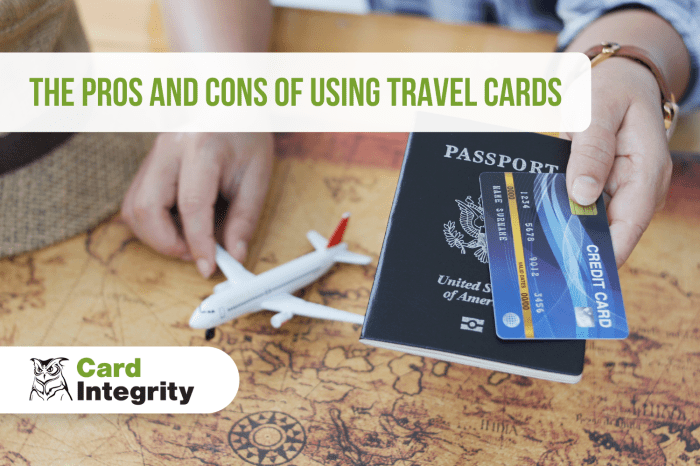Which item is a benefit of using the travel card – Which item is a benefit of using a travel card? That’s the million-dollar question for savvy travelers! This guide dives into the perks of travel cards, exploring everything from earning valuable rewards points and miles to accessing exclusive airport lounges and securing valuable travel insurance. We’ll unpack the advantages, compare different card offerings, and help you decide if a travel card is right for your next adventure.
Travel cards aren’t just plastic; they’re gateways to enhanced travel experiences. From accumulating points for free flights and hotel stays to enjoying peace of mind with built-in travel insurance, the benefits are numerous. Understanding these benefits empowers you to choose the card that best aligns with your travel style and spending habits. We’ll explore each benefit in detail, providing practical examples and comparisons to help you make an informed decision.
Travel Rewards Programs
Travel cards offer a compelling value proposition beyond simple travel insurance and airport lounge access: they provide access to lucrative rewards programs that can significantly offset the cost of travel and even make trips more affordable. Understanding the nuances of these programs is key to maximizing their benefits. This section will delve into the various reward structures and redemption options available.
Many travel cards operate on a points-based system, accumulating points for every dollar spent. These points can then be redeemed for various travel-related expenses. However, the specific structure and redemption options vary widely. Some cards offer miles, others points, and some even provide cashback that can be used towards travel.
Travel Card Reward Structures and Redemption Options
The following table compares the reward structures and redemption options of several popular travel cards. Note that specific details, including minimum redemption values, are subject to change and should be verified directly with the card issuer.
| Card Name | Reward Type | Redemption Options | Minimum Redemption Value |
|---|---|---|---|
| Chase Sapphire Preferred® Card | Chase Ultimate Rewards points | Flights, hotels, car rentals through the Chase Ultimate Rewards portal; transfer to partner airlines and hotels | 1,000 points |
| Capital One Venture Rewards Credit Card | Capital One miles | Statement credits for travel purchases; booking through Capital One Travel | 1 mile = $0.01 |
| American Express® Gold Card | Membership Rewards points | Flights, hotels, experiences; transfer to partner airlines and hotels | 1,000 points |
| Citi Premier® Card | ThankYou® points | Flights, hotels, merchandise; transfer to partner airlines and hotels | 1,000 points |
Value Proposition of Different Reward Currencies
The value you derive from your rewards depends on how you redeem them. Airline miles, for instance, can offer significant value when redeemed for premium cabin upgrades or international flights during peak season. However, the value can fluctuate based on award availability and fuel surcharges. Hotel points, on the other hand, can provide free nights at luxury hotels, representing a substantial savings, particularly for longer stays.
Cashback rewards offer a simpler, more predictable value proposition. While not as potentially lucrative as miles or points when redeemed strategically, cashback provides a guaranteed return on spending, making it a reliable option for travelers who prefer a straightforward approach. Consider a scenario where you accumulate $1000 in cashback. This can directly reduce the cost of your travel expenses by $1000.
Conversely, 100,000 airline miles might be worth $1000, but this value is dependent on availability and redemption options. The flexibility of using cashback is a significant advantage.
Travel Insurance Benefits

Many travel credit cards offer valuable travel insurance as a perk, adding an extra layer of protection to your adventures. This insurance can often cover unexpected events that could otherwise leave you with significant financial burdens. Understanding the types of coverage and comparing offerings across different cards is key to maximizing this benefit.Knowing the details of your travel insurance is crucial.
It can save you considerable stress and expense in unforeseen circumstances. Let’s explore the typical coverage and how it varies.
Types of Travel Insurance Coverage
Travel card insurance typically includes several key areas of protection. Trip cancellation insurance reimburses you for prepaid, non-refundable travel expenses if your trip is canceled due to covered reasons, such as a sudden illness or severe weather. Medical emergency insurance helps cover medical costs incurred while traveling abroad, which can be exceptionally high in some countries. Finally, baggage loss insurance compensates you for lost or damaged luggage, including the contents.
The specific details, limits, and exclusions vary widely depending on the card issuer and the specific card.
Comparison of Coverage Levels
The coverage levels offered by different travel cards vary significantly. Here’s a comparison based on common features:
- Trip Cancellation Coverage: Some cards offer coverage up to a few thousand dollars, while others may cover tens of thousands. Factors like the reason for cancellation (illness vs. weather) also influence reimbursement amounts. For example, Card A might offer $5,000 for medical reasons but only $2,000 for weather-related cancellations, while Card B might offer a flat $10,000 regardless of the reason.
- Medical Emergency Coverage: Coverage amounts for medical emergencies can range from a few thousand dollars to over a hundred thousand dollars. Cards often specify whether this coverage applies only to accidents or includes illnesses as well. For instance, Card C may cover up to $50,000 for medical emergencies, but only for accidents, while Card D provides $25,000 coverage for both accidents and illnesses.
- Baggage Loss Coverage: Similar variations exist in baggage loss coverage. Some cards offer a fixed amount per bag, while others have a total limit for all lost or damaged luggage. Some cards might also cover the cost of essential items purchased while waiting for replacement luggage. For example, Card E might offer $500 per checked bag, while Card F might offer a total of $1,000 for all lost or damaged items.
It’s important to carefully review your card’s terms and conditions to understand the specific limits and exclusions.
Examples of Beneficial Scenarios
Consider these scenarios where travel card insurance could prove invaluable:A sudden illness forces you to cancel a non-refundable $3,000 trip. Your travel card’s trip cancellation insurance could reimburse you for a significant portion, or even all, of these costs.While traveling abroad, you experience a serious medical emergency requiring hospitalization. Your travel card’s medical emergency insurance could cover thousands of dollars in medical bills, potentially saving you from crippling debt.Your luggage is lost or damaged during your travels, leaving you without essential belongings.
Your travel card’s baggage loss insurance could help replace your lost items, alleviating the inconvenience and expense.
Airport Lounge Access
Tired of crowded airport terminals and noisy gate areas? A travel rewards credit card can be your ticket to a much more relaxing travel experience, thanks to airport lounge access. This perk offers a haven of calm and comfort before your flight, significantly improving your overall journey.Airport lounge access, a benefit offered by many premium travel cards, provides a sanctuary away from the hustle and bustle of the typical airport experience.
These exclusive spaces offer a range of amenities designed to enhance your comfort and productivity, transforming a potentially stressful part of travel into a relaxing and enjoyable one.
Types of Airport Lounges
Various travel card programs offer access to different types of airport lounges. The most common include those affiliated with specific lounge networks, such as Priority Pass, Plaza Premium Lounge, and American Express Centurion Lounges. Some cards offer access to a broader network, while others might only grant access to a smaller, more exclusive selection of lounges. The level of access can also vary, with some cards providing unlimited visits while others might cap the number of visits per year.
Knowing which network your card grants access to is crucial in planning your travel. For example, a card offering Priority Pass access will provide access to a much wider array of lounges globally compared to a card only offering access to a single airline’s lounge network.
Lounge Access Comparison
The following table provides a simplified comparison of lounge access offered by a few example travel cards. Note that these are examples and the specific offerings can change. Always check the terms and conditions of your specific card for the most up-to-date information.
| Card Name | Lounge Access Details |
|---|---|
| Example Premium Card A | Priority Pass Select (unlimited visits), access to select airline lounges |
| Example Premium Card B | Access to American Express Centurion Lounges (subject to availability), limited visits to partner lounges |
| Example Rewards Card C | Access to one airline’s lounge network per year |
Travel Perks and Discounts

Beyond the points, travel insurance, and airport lounge access, many travel credit cards offer a range of additional perks and discounts designed to make your trip smoother and more affordable. These extras can significantly enhance your overall travel experience, turning a simple journey into a more enjoyable and rewarding one.Many travel credit cards offer a variety of valuable travel perks and discounts beyond the standard rewards programs.
These can translate to significant savings and a more comfortable travel experience.
Rental Car Discounts and Priority Services
Several travel credit cards partner with major rental car companies to offer cardholders exclusive discounts on rental rates. These discounts can range from a percentage off the total cost to special offers on upgrades or additional driver fees. Furthermore, some cards provide access to priority services, such as expedited check-in and bypassing long lines at the rental counter, saving you valuable time during your trip.
- Example 1: Imagine a 15% discount on a $500 rental car. That’s a $75 saving right there!
- Example 2: Priority service at the rental counter can save you upwards of 30 minutes, allowing you to get on the road and start your vacation sooner.
Hotel Discounts and Amenities
Similar to rental car discounts, some travel credit cards provide exclusive rates or special amenities at participating hotels. These deals can range from discounted room rates to complimentary upgrades, breakfast, or late check-out. These perks can add a significant touch of luxury to your stay without breaking the bank.
- Example 1: A 10% discount on a $200 hotel room saves you $20.
- Example 2: A complimentary breakfast can save you $20-$30 per day, especially when traveling with family.
Potential Cost Savings
The cumulative savings from these various perks can be substantial. For instance, combining a 15% discount on a rental car with a 10% discount on a hotel stay and a few free meals, you could easily save hundreds of dollars on a single trip. These savings can significantly offset the annual fee of some travel cards, making them a worthwhile investment for frequent travelers.
Even for occasional travelers, these discounts can make a noticeable difference in the overall cost of a vacation. Consider the convenience and time saved as an added bonus—invaluable when you’re already short on time.
Global Acceptance and Foreign Transaction Fees: Which Item Is A Benefit Of Using The Travel Card
Choosing the right travel card can significantly impact your trip’s overall cost, especially when traveling internationally. A card’s global acceptance and its foreign transaction fee policy are key factors to consider before you leave home. Understanding these aspects will help you avoid unexpected charges and maximize your travel budget.Global acceptance refers to how widely a credit or debit card is accepted at merchants and ATMs worldwide.
A card with extensive global acceptance ensures you can use it confidently in various locations, avoiding the inconvenience of carrying large amounts of cash or relying solely on local payment methods. This is particularly crucial in countries where credit card usage is less prevalent or where specific card networks might not be widely accepted.
Foreign Transaction Fee Comparison, Which item is a benefit of using the travel card
Different travel cards charge varying foreign transaction fees. These fees are percentages added to every transaction made in a foreign currency. Choosing a card with low or no foreign transaction fees can result in substantial savings, especially for trips involving numerous purchases. The following table compares the foreign transaction fees of four example cards (Note: These are examples and actual fees may vary.
Always check the current fees with the card issuer).
| Card Name | Foreign Transaction Fee | Annual Fee | Notes |
|---|---|---|---|
| Example Card A | 3% | $0 | Widely accepted globally. |
| Example Card B | 1% | $95 | High acceptance, but annual fee may offset savings for infrequent travelers. |
| Example Card C | 0% | $0 | Excellent for international travel, but may have stricter eligibility requirements. |
| Example Card D | 2.5% | $50 | Good acceptance, but the fee is higher than some alternatives. |
Savings from Low or No Foreign Transaction Fees
Let’s illustrate the potential savings. Imagine spending $1000 on a trip abroad. A card with a 3% foreign transaction fee would add $30 to your total cost. With a card charging no foreign transaction fee, you’d save this entire amount. On a more extensive trip with higher spending, these savings become even more significant.
For example, a $3000 trip would incur a $90 fee with a 3% transaction fee, compared to zero with a no-fee card. The cumulative savings over multiple trips can be substantial, making the choice of a card with low or no foreign transaction fees a smart financial decision for frequent international travelers.
Ultimately, the “best” travel card benefit depends on your individual travel priorities. Do you prioritize earning rewards points for free flights? Or is comprehensive travel insurance your top concern? Perhaps exclusive airport lounge access is your ultimate travel luxury. By carefully weighing the benefits discussed—from rewards programs and insurance to airport perks and purchase protection—you can select a travel card that maximizes your travel experience and saves you money.
So, start exploring your options and unlock the world of travel card benefits!
Essential Questionnaire
How do I choose the right travel card for me?
Consider your typical travel spending and preferences. If you fly frequently, a card with airline miles might be best. If you value insurance, prioritize cards with robust coverage. Compare annual fees, interest rates, and rewards programs to find the perfect fit.
Are there any downsides to travel cards?
Yes, some cards have annual fees, and it’s crucial to pay your balance in full each month to avoid high interest charges. Always read the fine print and understand the terms and conditions before applying.
Can I use my travel card internationally?
Most travel cards offer international use, but check for foreign transaction fees. Some cards waive these fees, saving you money on international purchases.
What happens if my travel plans change and I need to cancel my trip?
Many travel cards offer trip cancellation insurance. Check your policy details to understand the coverage and claim process. Documentation is key in such situations.


